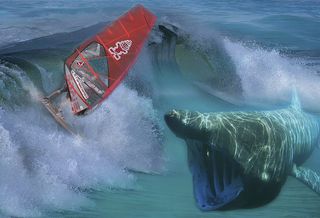Mating
If You Meet a Shark in the Dating Pool, Swim Away!
Early abuse can increase risk of entering dangerous relationships.
Posted October 14, 2016
Today, per a reader’s request, I will zoom in on point “c” (highlighted in bold below).
When you meet someone new and begin to have private feelings that they are your “soulmate,” in reality this may signal one of three things:
a) To start on a hopeful foot, it may be the real deal…the kind of love that is invigorating, freeing and sustainable for the rest of your life.
b) Or these feelings may be the very common “folie a deux” (madness shared by two) that you are perfectly compatible, which may turn out to be quite off-base and may result in later feelings of disappointment or heartbreak.
c) Or, these feelings may be echoes of former trauma that may signal a relationship that will morph into the nightmare of the abusive situation.
Point “c” is based on my observation of what seems to be a magnetic pull during courtship (i.e. the “cocaine-rush phase” in my model) between perpetrators of abuse and their victims.
First, though, to be fair, I think there is a universal tendency for all of us to either repeat the patterns in our families of origin, or, to the degree that we are conscious of them, to actively propel ourselves in the opposite direction. Consider, for instance, the line of research that demonstrates that individuals who have alcoholic parents are more to become alcoholic themselves. While this may be true, it is also equally true that those who have alcoholic parents are also more likely to become teetotalers – in other words, people who don’t touch alcohol at all. Or think about something less emotionally charged than substance dependence…like parenting style. We are likely to either mimic and replicate the parenting style of our parents, or to intentionally decide that we will not do family like family was done to us. So the point here is not that those of us with abusive upbringings rush headlong like lemmings over the cliff into an abusive future relationship. Nonetheless, there may be an elevated risk factor for future abuse for a number of reasons.
What is the source of the “magnetic pull” between a perpetrator and a victim? The source may come from either - or both – partners in the relationship. People who use domination as their main mode of operation will naturally seek those whose social cuing suggests a more submissive behavioral pattern. One of the more chilling studies* I have reviewed asked criminals to watch videos of several women walking down the street. The question put to them was this: “Which of these women would you victimize?” With striking consistency, they often identified the same individuals as mugging targets. What this suggests is that even if we do not utter a word, our nonverbal behaviors announce to others whether we are likely to be susceptible to predatory overtures.
In reviewing peoples’ responses to this line of research, several individuals noted discomfort around the idea that this “blames the victim.” I do not see it this way. If the study's observed effects are true, then it does not do any of us any good to get trapped in a politically correct hall of mirrors. It would be far wiser to arm ourselves with any truths that might help us change the course of a dangerous path. Based on social learning theory, it seems pretty reasonable to theorize that our nonverbal behavior is in large part a consequence of our lived experiences. And doesn't it seem reasonable as well that nonverbal behavior shaped by previous life history could influence future interactions?

Essentially, if we grew up in a home where abuse was common, chaotic relationships were the norm, and boundaries were not respected, it would seem reasonable that this might translate into multiple levels of how we express ourselves socially, including our nonverbal cuing. And if we agree that this is likely, this nonverbal cuing may chum the water for psychopathic sharks in the dating pool. So, in this way, a history of abuse could elevate the risk of being targeted by someone with the will to dominate.
I have also made the point that during the courtship phase, we test each others' limits in order to develop implicit rules of relationship. Again, the shark analogy is helpful here because there are many ways that a “shark” in human skin can bump up against potential victims to see how they will respond to being nosed in this way. In dating relationships, the analogy to bumping as a test might be a person who often flakes out, or suddenly withdraws affection with no explanation. If we are on the receiving end of this, the way that we respond to these behavioral patterns tells our partners what we will stand for (or not). And as I hear the stories of both females and males who seem to be dating these kinds of “sharks,” I hear evidence of a plethora of these micro-transactions that to me speak to testing limits and violating subtle boundaries. And, as such, part of this magnetic force I am referencing is the seeking behavior of someone with a predatory nature.
The other part of the magnetic force, however, may come from the innocent person who ends up in an abusive dynamic. That is, unhealed wounds from past trauma in our lives may not only point sharks in our direction, they may also create certain blind spots that lead us to make dangerous choices. No one can claim to know the true reason why this happens. Some have theorized that there is an unfortunate tendency to select partners with whom we will re-stage traumas similar to those we have experienced in the past (e.g., the son of a verbally abusive mother will often end up with a verbally abusive wife). We might do this presumably with the hope of getting a different outcome…perhaps just to pave over the pain or maybe to forge a sense of agency in what resembles a helpless scenario from our past. While the nonverbal cuing hypothesis makes sense to me, for some reason, this interpretation has always made me feel uncomfortable – this to me brings us perilously close to victim blaming. If we do actually do this, I would imagine it is certainly not with a conscious intent to live through the nightmare of a trauma again.
Another equally (or more?) likely possibility is that when we have experienced prolonged trauma, we naturally become habituated to being traumatized. This explanation would account for the understanding that no one actually wants to repeat trauma. However, individuals who have experienced trauma may have a difficult time recognizing sharks who present themselves as potential relationship partners because they somehow “feel like home.” Or, to put it another way, when you have been treated badly over a long period of time, perhaps it is hard to know what right looks like and what it feels like to be treated with respect. It therefore becomes particularly challenging to differentiate safe from unsafe people.
To conclude this string of thoughts, it feels important to make the point that if our experiences shape both our cuing and our read on others, then it is also absolutely true that working through trauma will change these things in a positive direction. Getting a clear picture of what a healthy relationship looks like and learning how to transmit healthy boundaries changes our body language in fundamental ways – we make more eye contact, our vocal tone changes, we hold our posture differently - we move through space and negotiate our relationships differently. I have seen this transformation happen with many of my therapy patients – both female and male.
Sometimes I even refer to this as “building a shark cage” (and please don’t assume that females are the only gender who need the protection of shark cages). In these cases, the work we undertake together will not only address areas of trauma, shame and learned vulnerability, but will also help arm these patients with good information about what to look for and how to protect themselves in future dating situations. My ultimate goal is to both make my patients less attractive to predatory people in the first place and more equipped to swim away should they encounter sharks in the future.
Citations
*Grayson, B. & Stein, M.L. (1981). Attracting assault: victim’s nonverbal cues. Journal of Communication, 31 (1), 68-75.
http://www.bbc.com/future/story/20131104-how-muggers-size-up-your-walk
References
Of Note: This writer was contacted by a Ms. Ursula Benstead who shared that she has developed a comprehensive framework using a Shark Cage® metaphor for the treatment of women who have experienced sexual assault and/or family violence. For more information about her work, please see the article “The Shark Cage: the use of metaphor with women who have experienced abuse” (Benstead, Psychotherapy in Australia, Vol 17, February, 2011) https://www.ursulabenstead.com.au/#Article_Access




